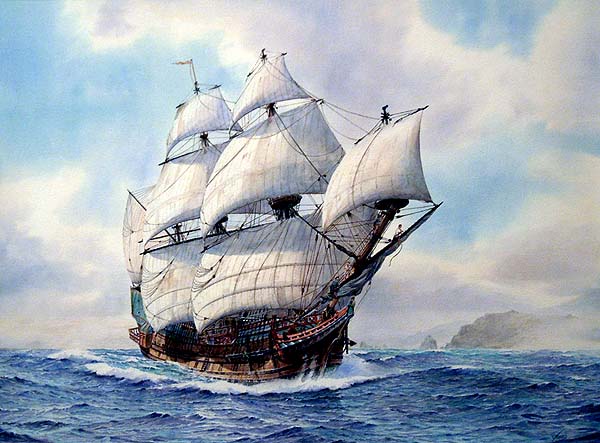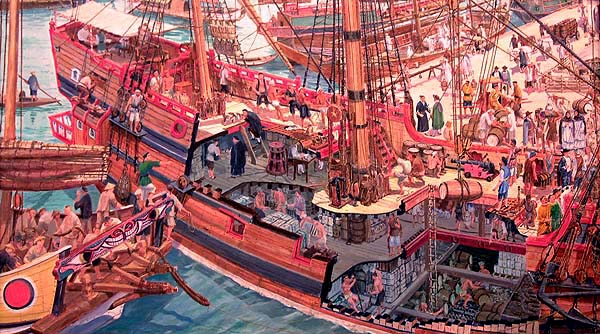 |
 |
 |
|||||
|
|
|
|
|
|
|
|
|
|
|
|||||||
|
|
|
|
|
|
“Looking at the captain’s log sheet, they always pinpoint that Guam was the first place that the Spanish arrived when Magellan came in the 1500s,” Noel says, “but now scholars are saying, ‘Wait a minute.’ Looking at the longitude and the latitude of where they were, I think they came here first, to Saipan, because you can see Managaha, Tinian and Aguijan island. If you go to Guam, you don’t see that. So I think the first encounter was probably here. Or the northern part of the island, especially like the Managaha area, up around in Tanapag. I’m very sure they were there."
|
||
|
|
||
"But it wasn’t really
a happy arrival. Maybe for the Chamorros, because they knew about
metal in the side of the ship. I guess the Spanish were trying to trade
for food, water and everything; and Chamorros hopped in the ship and
were yanking off the metal. "They must have had metal before. My grandmother told me they already knew about it—that the Chamorros brought some, and as time went by, it eroded. How could the Spanish introduce it to us when we have our own word for metal? We have the word lulok, an indigenous word for metal. In some place it’s called pesi, si, and in Chamorro seethatcie means ‘metal,’ and in our language we have se’se’, meaning ‘knife.’ Why would we have indigenous word for 'knife'? So that says to me, they knew about metal."
|
|
|
"I think they brought metal with them, because if you really look at it, when you're going to sail your canoe with lots of your other people, what are the first things you take with you? You take tools, weapons, food, potteries of water, a lot of fishing implements, hooks, fishing spears, nets. Everything that’s important, you take it with you and primarily those are the tools. And tools will have metal. Then when they came here it probably eroded and, of course they can’t find a replacement, so they use stone and tridacna. "Then when they saw the Spanish they said, ‘There it is guys! Hey guys, there’s metal there!’ So when they hopped in the ship, they started yanking off whatever boards they can get, anything that has to do with metal, to melt it down for the metal parts they want to use, to make their adze and their axes. So they knew about metal."
|
"And our people also tried to trade rice to the Spanish. That’s why they called us landrones ('thieves'), because in the bottom of the rice sack, it was full of rocks. So the Chamorros tried to cheat them. Well, I don’t think they were really terrible. It’s just like they said, ‘Wait a minute, let’s fool these guys.’ “So, I think the Spanish came here first, and then they had some kind of small encounter and they left. They probably saw that the island is not that big, and then they went to Guam and saw it’s bigger and said, ‘Hey, let’s stay here.’ "And then Legaspi came, and other Spanish sailors probably stopped at Saipan. There’s a cannonball that was found in Tanapag. And it’s made out of bronze, about two or three inches in diameter. Some American man found it on the beach and he donated it to the museum. But it must have come from somewhere. Not from the Japanese; it’s all bronze."
|
|
|
|
|
|
“The Concepción is a Spanish ship that came from Acapulco and it crashed here in the Agingan Point, the southern point of Saipan, in 1638. They were carrying a lot of cargo, from Chinese money to silver, muskets. There was silver Spanish money, Spanish coins. A lot of it was salvaged by the Spanish after learning of the Concepción’s tragedy. And what else they had is gold. Some of the gold that has been found from here is beautiful stuff. So intricate they way they’re made, it’s unbelievable.”
|
||
|
|
||
"We have a model that was made of the Concepción, and a drawing of the trading and all the cargos, containers and whatnot. Supposedly it’s set in Manila Bay. And it shows the Chinese junk ships, how they traded with the Spanish. Bear in mind, not only were the Spanish here, but also the Portuguese were trading. And Portugal and Spain were not friends, they were killing each other. They were stealing each other’s cargo. "These pots are part of the galleon cargo, out of the Concepción. I think that this is the container where they put all the spices—cinnamon, curry—to be shipped to Spain and to Europe and to the New World. These are the containers that, if you ordered an item, I think the symbol on the container would reflect your identity, where the container is going. Then they can reuse the container again."
|
|
|
"Chamorro society at this time was in order. They had their own laws. They had their own warfare law. Everybody was living peacefully. They were not really warriors, because what the Spanish recorded, and even from my grandfather, he said that among the Chamorros, when there’s fighting, after one or two injuries or deaths is peace right away. And then after peace is obtained, the winning family, the winning village, will gather their precious commodities (which is turtle shells and other kinds of wealth) and then will go down to the losing village to give it to the wife of the deceased. "When the Spanish arrived, the Chamorro position was, ‘When we have war, you’re only supposed to kill one—that’s a law.’ That’s probably how the Chamorros lost the war, is that maybe one or two Chamorros would die from the musket and maybe the Chamorro says, ‘Okay, peace there and war no more.’ But then the Spanish kept shooting."
|
|
|
|
“Then the Spanish didn’t come up here much. It’s not until 1668 that the Spanish actually established the mission. That’s when the priests started to really write down a lot of things about the settlement of the Europeans here in the Marianas.” And that takes us to a discussion of missionaries.
|
||
|
|
||
|
|
|
|
|
|

|
| Tanapag Home | Map Library | Site Map | Pacific Worlds Home |
|
|
|
|

|
|
|
|||
| Copyright 2003 Pacific Worlds & Associates • Usage Policy • Webmaster |
|||








